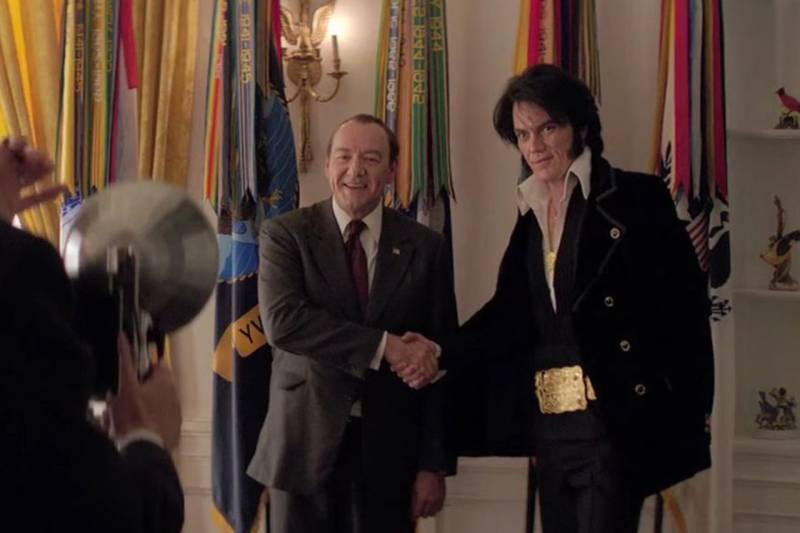The writer cum director Liza Johnson’s latest directorial venture, Elvis & Nixon, is a historical fiction, based on the worth mentioning sequence of real events behind the surreal meeting of Elvis Presley and President Richard Nixon on December 21, 1970. The awkward duo met for the most awkward motives. Both of them were looking for something to earn. In the end, both seemed contented with the outcome. It was precisely a perfect day of maneuverings, secrecy, and clodhopping.
Some of the depictions are fact, some are works of fiction, but all are worth remembering. The movie is all about the tangible things happened behind-closed-doors of Oval office on the day of real-life dramatic summit between The King of Rock 'n Roll and 37th President of United States of America, leading up to a highly celebrated and most requested image in American history.
Based on the true yet bizarre moment ever in history of White House, the movie narrates the outlandish incident when Elvis Presley, (played by Michael Shannon), dressed in his eccentric fashion style, set foot on White House entrance to drop a six page hand-written letter for the then president Nixon (played by Kevin Spacey), requesting a meetup with him. The main purpose behind the unusual meeting was to obtain an official badge of the federal Bureau of Narcotics and Dangerous Drugs. In his letter, Elvis explained he wants to play active role in eliminating drug culture:
“I can and will do more good if I were made a Federal Agent at Large, and I will help out by doing it my way through communications with people of all ages”
Elvis’s hand-written letter passed to Egil Krogh (Colin Hanks), a White House Deputy for Domestic Affairs. Being a fan of The King himself, Krogh adored the fascinating concept of an encounter between two influential men. He along with Dwight Chapin (Evan Peters), convinced their superiors to allow this chance meeting.
Happy to meet the president of his country, the style icon arrived at the White House in his peculiar fashion – wearing a dark velvet suit, a Lord Byron style shirt embellished with gold belt and large buckle, his showy made-to-order jewelry, signature sunglasses and shoes. He carried a unique gift – a gold plated Colt .45 pistol, in a wood and glass box, to be presented to Nixon.
The rest of the movie revolves around the awe-struck moment of Presley at presidential office. The King not only talked about his passion for collecting police badges but also showed his cufflinks to Nixon who admired them instantly. From casual discussions about families to global political scenarios, from communist brain-washing techniques and The Beatles’ anti-American sentiments to hippie culture, Black Panthers and finally a request for a badge of secret Federal Agent at Large were the highlights of the awkward encounter. In return, Elvis offered his help to fight drug culture and infiltrate dissident groups in America. Emotionally charged Elvis told the President:
“I’m on your side"
At the end of the historic meeting, the two influential men posed for a photograph that turned out to be the most requested photo in the history of White House’ National Archives.

We all don’t really know what happened during the 30-minute meeting because the recording system was not installed in the Oval office at that time. However, all the details in the movie are based on notes of Krogh who later published a book The Day Elvis Met Nixon about the famous meeting. On Elvis’s wish, the unforgettable meeting remained a secret, until an investigative journalist broke the story.
Johnson along with her screenwriters Joey Sagal, Hanala Sagal and Cary Elwes, tried her best to turn the plot into a witty and entertaining one while polishing the absurdity and improbability of such meetup. The story has some elements of situational comedy and out of place wackiness, but, it remained quite concentrated on the practicalities of the one-on-one meeting.
As far as the performances are concerned, due to lack of physical resemblance, it is really difficult to digest Shannon as Elvis Presley. Although, the costumes were nicely handled, but, the weird facial expressions, odd wigs and improper voice and gestures made it impossible to connect it with the original one. The tall and slim Shannon mostly failed to deliver a performance that can be remembered as his outstanding work.
Similarly, Spacey doesn’t looked like Nixon. He portrayed a prudent-angered president who upon meeting the famous singer quickly changes into a radical fascinator; thus revealing a satirical target. The crouched pose and the bent hand movements are some of his acting highlights. There is no doubt that both performers muddle through somehow to deliver an immaculate perception of two distinguished men.
In a nutshell, Elvis and Nixon is sharply weaved humorous as well as enlightening story about the similitudes among affairs of state and non-financial social assets. The cinematography perfectly harmonizes with storyline and flawlessly incorporates with library videotapes. If you are a fan of Elvis Presley and have any interest in this kind of historical fiction cum fact-movie, it is definitely worth your time. Solely based on its good pace and witty dialogues, I would rate it three stars out of five.






